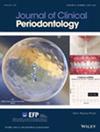Cost Effectiveness of Two Short Implants Versus One Short Implant With a Cantilever in the Posterior Region: 7.5-Year Follow-Up of a Randomised Controlled Trial.
IF 6.8
1区 医学
Q1 DENTISTRY, ORAL SURGERY & MEDICINE
引用次数: 0
Abstract
AIM To compare long-term clinical and radiographic outcomes of a single short implant (6 mm) supporting a cantilevered restoration versus two adjacent short implants with non-splinted single crowns over a 7.5-year follow-up and determine which approach is more cost effective. MATERIALS AND METHODS A total of 36 patients with at least a two-tooth gap in the posterior region were randomised to receive either one short implant with a cantilever prosthesis (ONE-C) or two short implants with individual crowns (TWO). Fixed restorations were placed 3-6 months post implantation, and patients were evaluated at baseline and at 6 months and 1, 3, 5 and 7.5 years. Kaplan-Meier curves, mixed-effects models and cost-effectiveness models were used to compare the groups. RESULTS Twenty-five patients (15 in ONE-C, 10 in TWO) completed the 7.5-year follow-up. Implant survival was 83.3% in group ONE-C and 86.6% in group TWO, with no significant differences between the groups (p = 0.772). No statistically significant differences were found between groups for marginal bone levels (mean difference -0.16 [95% CI: -0.7 to 0.3] p = 0.57), probing depth (mean difference -0.13 [95% CI: -0.5 to 0.3] p = 0.58), bleeding on probing (mean difference 0.0 [95% CI: -0.0; 0.2] p = 0.31) or plaque levels (mean difference -0.0 [95% CI: -0.1 to 0.1] p = 0.93). Technical complications were more frequent in the ONE-C group (64%) than in the TWO group (36%). CONCLUSION Both treatment approaches showed comparable clinical and radiographic outcomes. Short implants supporting cantilever restorations were generally more cost effective than two short implants but exhibited higher early complication and failure rates, likely related to mechanical overload. TRIAL REGISTRATION ClinicalTrials.gov Identifier: NCT01649531.两个短种植体与一个短种植体的成本效益与后区悬臂:7.5年随访的随机对照试验。
目的:通过7.5年的随访,比较单个短种植体(6mm)支持悬臂式修复与相邻两个短种植体无夹板单冠的长期临床和影像学结果,并确定哪种方法更具成本效益。材料和方法共36例后牙区至少有两颗牙间隙的患者被随机分为两组,一组接受一个短种植体与悬臂种植体(one - c),另一组接受两个短种植体与单个冠(two)。植入后3-6个月放置固定修复体,并在基线、6个月、1、3、5和7.5年对患者进行评估。采用Kaplan-Meier曲线、混合效应模型和成本-效果模型进行组间比较。结果25例患者(ONE-C组15例,TWO组10例)完成了7.5年的随访。ONE-C组种植体成活率为83.3%,TWO组为86.6%,组间差异无统计学意义(p = 0.772)。在边缘骨水平(平均差值-0.16 [95% CI: -0.7至0.3]p = 0.57)、探探深度(平均差值-0.13 [95% CI: -0.5至0.3]p = 0.58)、探探出血(平均差值0.0 [95% CI: -0.0; 0.2] p = 0.31)或斑块水平(平均差值-0.0 [95% CI: -0.1至0.1]p = 0.93)方面,两组间无统计学差异。技术并发症在ONE-C组(64%)比TWO组(36%)更频繁。结论两种治疗方法的临床和影像学结果相当。短种植体支持悬臂式修复通常比两个短种植体更具成本效益,但表现出更高的早期并发症和失败率,可能与机械过载有关。临床试验注册号:NCT01649531。
本文章由计算机程序翻译,如有差异,请以英文原文为准。
求助全文
约1分钟内获得全文
求助全文
来源期刊

Journal of Clinical Periodontology
医学-牙科与口腔外科
CiteScore
13.30
自引率
10.40%
发文量
175
审稿时长
3-8 weeks
期刊介绍:
Journal of Clinical Periodontology was founded by the British, Dutch, French, German, Scandinavian, and Swiss Societies of Periodontology.
The aim of the Journal of Clinical Periodontology is to provide the platform for exchange of scientific and clinical progress in the field of Periodontology and allied disciplines, and to do so at the highest possible level. The Journal also aims to facilitate the application of new scientific knowledge to the daily practice of the concerned disciplines and addresses both practicing clinicians and academics. The Journal is the official publication of the European Federation of Periodontology but wishes to retain its international scope.
The Journal publishes original contributions of high scientific merit in the fields of periodontology and implant dentistry. Its scope encompasses the physiology and pathology of the periodontium, the tissue integration of dental implants, the biology and the modulation of periodontal and alveolar bone healing and regeneration, diagnosis, epidemiology, prevention and therapy of periodontal disease, the clinical aspects of tooth replacement with dental implants, and the comprehensive rehabilitation of the periodontal patient. Review articles by experts on new developments in basic and applied periodontal science and associated dental disciplines, advances in periodontal or implant techniques and procedures, and case reports which illustrate important new information are also welcome.
 求助内容:
求助内容: 应助结果提醒方式:
应助结果提醒方式:


